BUSN20016 Project Outline: White-Collar Crime and Ethical Culture
VerifiedAdded on 2022/09/18
|7
|1403
|25
Report
AI Summary
This report provides an outline for a research project investigating white-collar crime and its relationship to corporate culture. It addresses the increasing prevalence of white-collar offenses, the individual and organizational factors contributing to such crimes, and the potential for ethical corporate cultures to mitigate rule-violating behavior. The project aims to analyze the reasons behind white-collar crime, the consequences on economic and social factors, and how developing an ethical corporate culture can help organizations in reducing business corruptions. The methodology includes a literature review, data collection from industry and government reports, and interviews with employees in large corporations to gain real-world insights. The analysis will involve both descriptive and analytical methods, with data presented in tables and charts to identify relationships between variables.
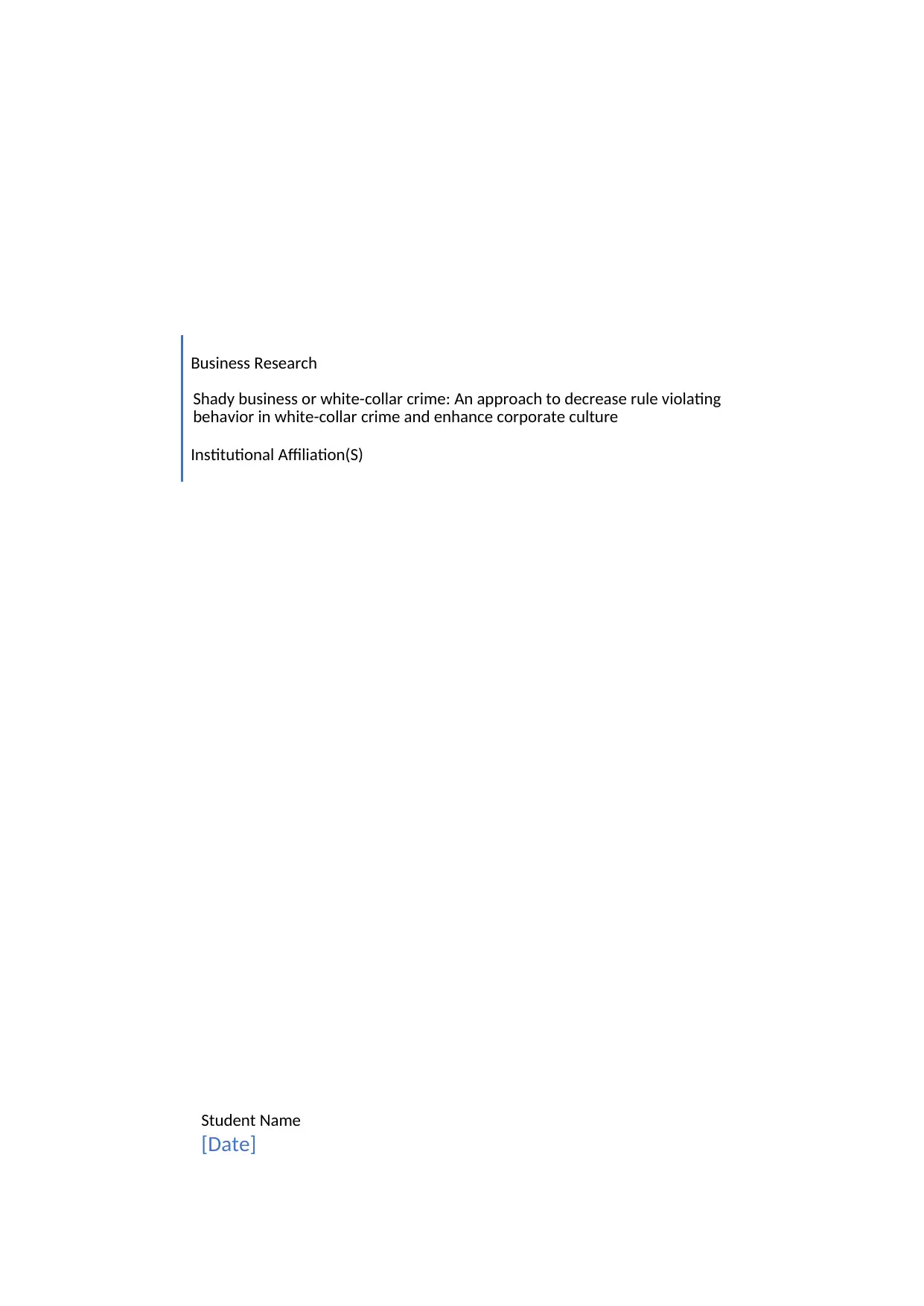
Business Research
Shady business or white-collar crime: An approach to decrease rule violating
behavior in white-collar crime and enhance corporate culture
Institutional Affiliation(S)
Student Name
[Date]
Shady business or white-collar crime: An approach to decrease rule violating
behavior in white-collar crime and enhance corporate culture
Institutional Affiliation(S)
Student Name
[Date]
Paraphrase This Document
Need a fresh take? Get an instant paraphrase of this document with our AI Paraphraser
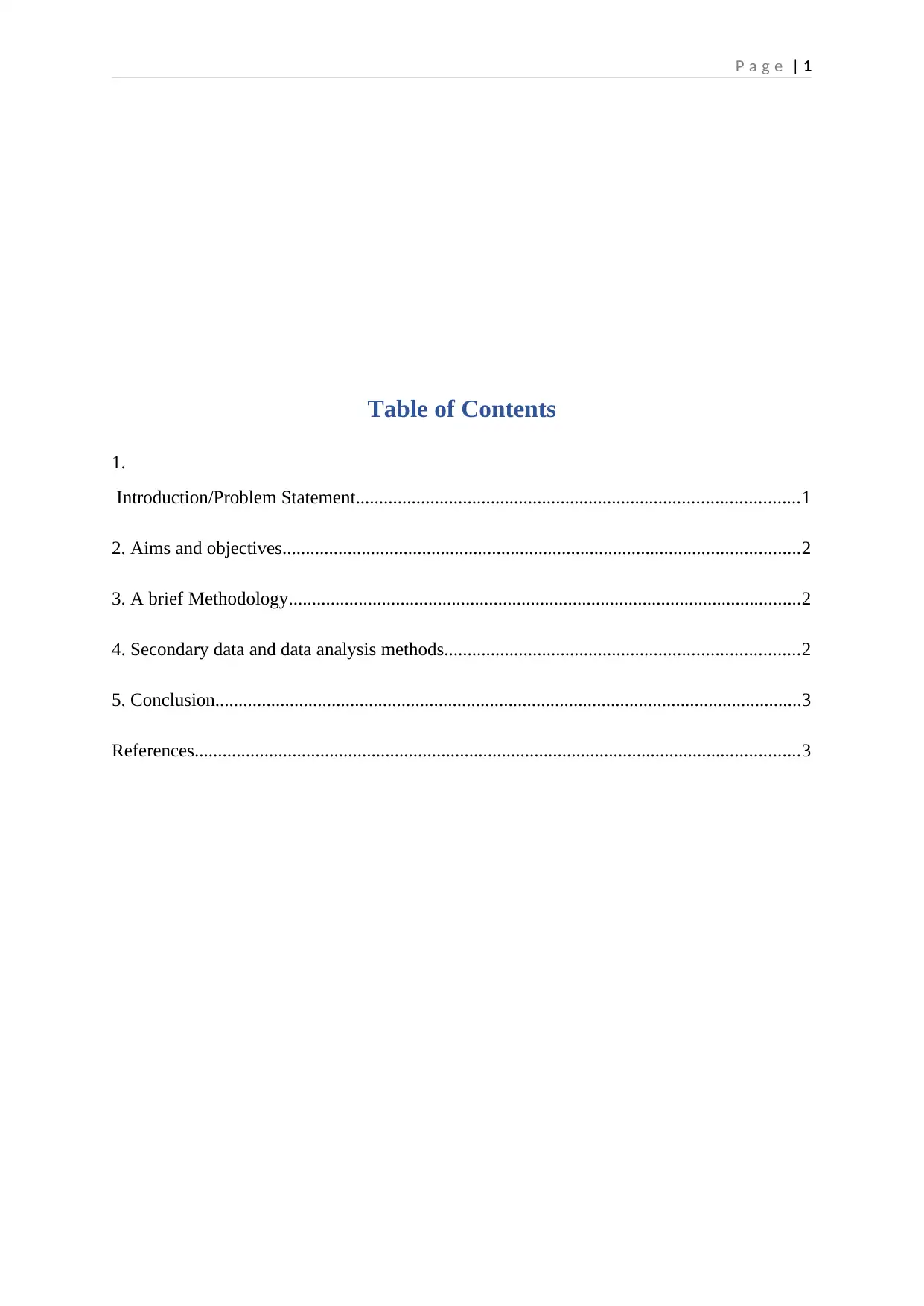
P a g e | 1
Table of Contents
1.
Introduction/Problem Statement...............................................................................................1
2. Aims and objectives...............................................................................................................2
3. A brief Methodology..............................................................................................................2
4. Secondary data and data analysis methods............................................................................2
5. Conclusion..............................................................................................................................3
References..................................................................................................................................3
Table of Contents
1.
Introduction/Problem Statement...............................................................................................1
2. Aims and objectives...............................................................................................................2
3. A brief Methodology..............................................................................................................2
4. Secondary data and data analysis methods............................................................................2
5. Conclusion..............................................................................................................................3
References..................................................................................................................................3
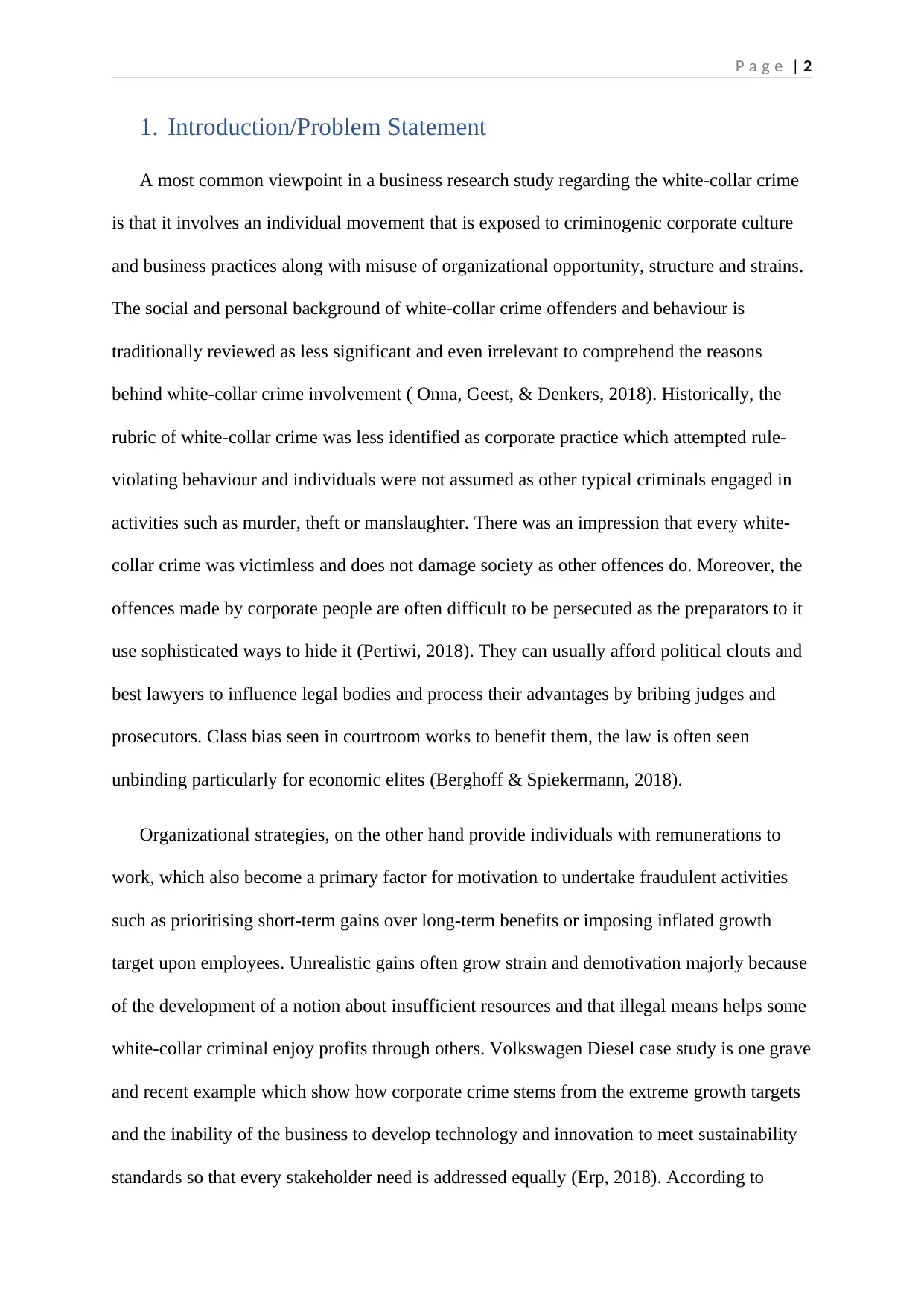
P a g e | 2
1. Introduction/Problem Statement
A most common viewpoint in a business research study regarding the white-collar crime
is that it involves an individual movement that is exposed to criminogenic corporate culture
and business practices along with misuse of organizational opportunity, structure and strains.
The social and personal background of white-collar crime offenders and behaviour is
traditionally reviewed as less significant and even irrelevant to comprehend the reasons
behind white-collar crime involvement ( Onna, Geest, & Denkers, 2018). Historically, the
rubric of white-collar crime was less identified as corporate practice which attempted rule-
violating behaviour and individuals were not assumed as other typical criminals engaged in
activities such as murder, theft or manslaughter. There was an impression that every white-
collar crime was victimless and does not damage society as other offences do. Moreover, the
offences made by corporate people are often difficult to be persecuted as the preparators to it
use sophisticated ways to hide it (Pertiwi, 2018). They can usually afford political clouts and
best lawyers to influence legal bodies and process their advantages by bribing judges and
prosecutors. Class bias seen in courtroom works to benefit them, the law is often seen
unbinding particularly for economic elites (Berghoff & Spiekermann, 2018).
Organizational strategies, on the other hand provide individuals with remunerations to
work, which also become a primary factor for motivation to undertake fraudulent activities
such as prioritising short-term gains over long-term benefits or imposing inflated growth
target upon employees. Unrealistic gains often grow strain and demotivation majorly because
of the development of a notion about insufficient resources and that illegal means helps some
white-collar criminal enjoy profits through others. Volkswagen Diesel case study is one grave
and recent example which show how corporate crime stems from the extreme growth targets
and the inability of the business to develop technology and innovation to meet sustainability
standards so that every stakeholder need is addressed equally (Erp, 2018). According to
1. Introduction/Problem Statement
A most common viewpoint in a business research study regarding the white-collar crime
is that it involves an individual movement that is exposed to criminogenic corporate culture
and business practices along with misuse of organizational opportunity, structure and strains.
The social and personal background of white-collar crime offenders and behaviour is
traditionally reviewed as less significant and even irrelevant to comprehend the reasons
behind white-collar crime involvement ( Onna, Geest, & Denkers, 2018). Historically, the
rubric of white-collar crime was less identified as corporate practice which attempted rule-
violating behaviour and individuals were not assumed as other typical criminals engaged in
activities such as murder, theft or manslaughter. There was an impression that every white-
collar crime was victimless and does not damage society as other offences do. Moreover, the
offences made by corporate people are often difficult to be persecuted as the preparators to it
use sophisticated ways to hide it (Pertiwi, 2018). They can usually afford political clouts and
best lawyers to influence legal bodies and process their advantages by bribing judges and
prosecutors. Class bias seen in courtroom works to benefit them, the law is often seen
unbinding particularly for economic elites (Berghoff & Spiekermann, 2018).
Organizational strategies, on the other hand provide individuals with remunerations to
work, which also become a primary factor for motivation to undertake fraudulent activities
such as prioritising short-term gains over long-term benefits or imposing inflated growth
target upon employees. Unrealistic gains often grow strain and demotivation majorly because
of the development of a notion about insufficient resources and that illegal means helps some
white-collar criminal enjoy profits through others. Volkswagen Diesel case study is one grave
and recent example which show how corporate crime stems from the extreme growth targets
and the inability of the business to develop technology and innovation to meet sustainability
standards so that every stakeholder need is addressed equally (Erp, 2018). According to
⊘ This is a preview!⊘
Do you want full access?
Subscribe today to unlock all pages.

Trusted by 1+ million students worldwide
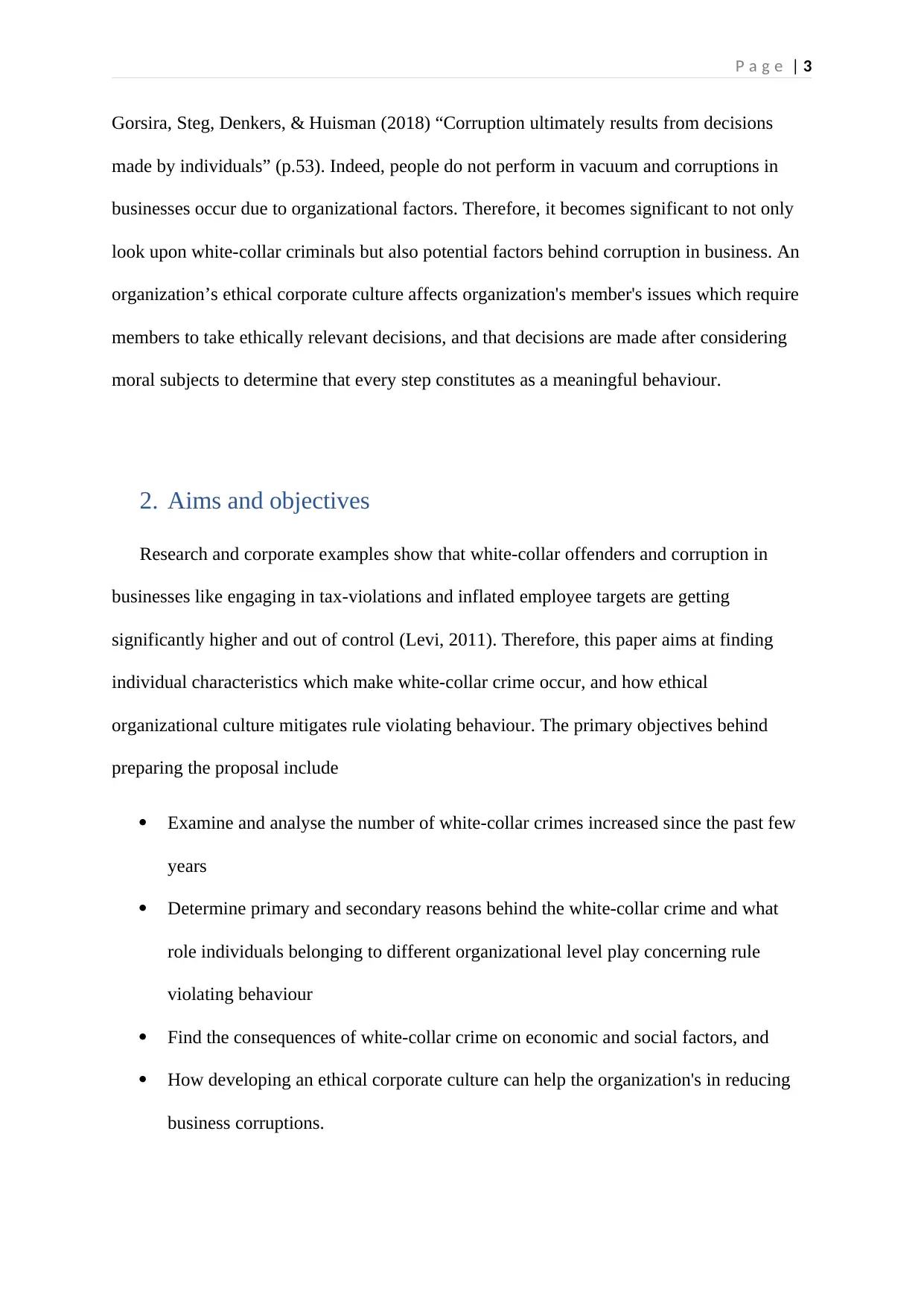
P a g e | 3
Gorsira, Steg, Denkers, & Huisman (2018) “Corruption ultimately results from decisions
made by individuals” (p.53). Indeed, people do not perform in vacuum and corruptions in
businesses occur due to organizational factors. Therefore, it becomes significant to not only
look upon white-collar criminals but also potential factors behind corruption in business. An
organization’s ethical corporate culture affects organization's member's issues which require
members to take ethically relevant decisions, and that decisions are made after considering
moral subjects to determine that every step constitutes as a meaningful behaviour.
2. Aims and objectives
Research and corporate examples show that white-collar offenders and corruption in
businesses like engaging in tax-violations and inflated employee targets are getting
significantly higher and out of control (Levi, 2011). Therefore, this paper aims at finding
individual characteristics which make white-collar crime occur, and how ethical
organizational culture mitigates rule violating behaviour. The primary objectives behind
preparing the proposal include
Examine and analyse the number of white-collar crimes increased since the past few
years
Determine primary and secondary reasons behind the white-collar crime and what
role individuals belonging to different organizational level play concerning rule
violating behaviour
Find the consequences of white-collar crime on economic and social factors, and
How developing an ethical corporate culture can help the organization's in reducing
business corruptions.
Gorsira, Steg, Denkers, & Huisman (2018) “Corruption ultimately results from decisions
made by individuals” (p.53). Indeed, people do not perform in vacuum and corruptions in
businesses occur due to organizational factors. Therefore, it becomes significant to not only
look upon white-collar criminals but also potential factors behind corruption in business. An
organization’s ethical corporate culture affects organization's member's issues which require
members to take ethically relevant decisions, and that decisions are made after considering
moral subjects to determine that every step constitutes as a meaningful behaviour.
2. Aims and objectives
Research and corporate examples show that white-collar offenders and corruption in
businesses like engaging in tax-violations and inflated employee targets are getting
significantly higher and out of control (Levi, 2011). Therefore, this paper aims at finding
individual characteristics which make white-collar crime occur, and how ethical
organizational culture mitigates rule violating behaviour. The primary objectives behind
preparing the proposal include
Examine and analyse the number of white-collar crimes increased since the past few
years
Determine primary and secondary reasons behind the white-collar crime and what
role individuals belonging to different organizational level play concerning rule
violating behaviour
Find the consequences of white-collar crime on economic and social factors, and
How developing an ethical corporate culture can help the organization's in reducing
business corruptions.
Paraphrase This Document
Need a fresh take? Get an instant paraphrase of this document with our AI Paraphraser
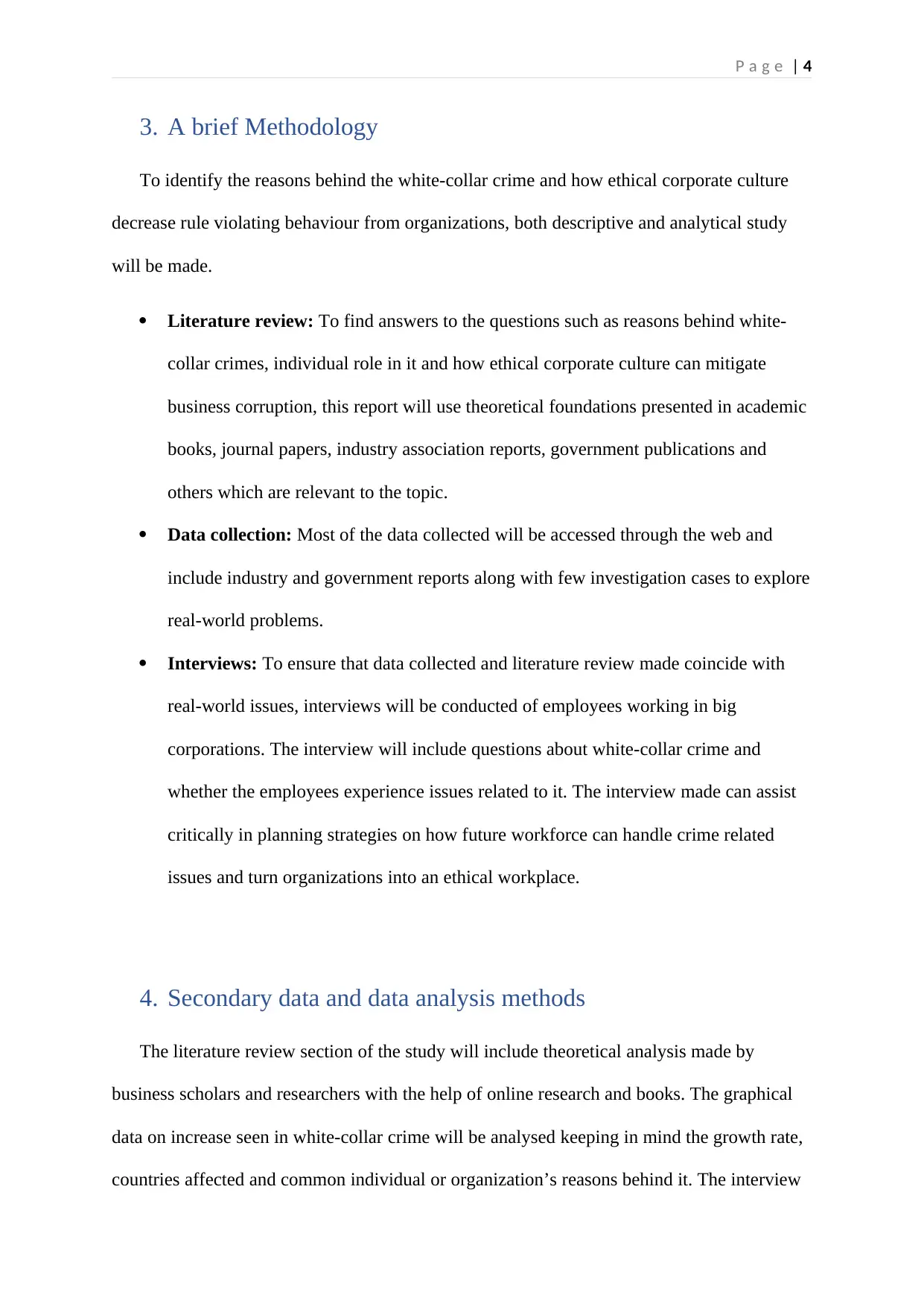
P a g e | 4
3. A brief Methodology
To identify the reasons behind the white-collar crime and how ethical corporate culture
decrease rule violating behaviour from organizations, both descriptive and analytical study
will be made.
Literature review: To find answers to the questions such as reasons behind white-
collar crimes, individual role in it and how ethical corporate culture can mitigate
business corruption, this report will use theoretical foundations presented in academic
books, journal papers, industry association reports, government publications and
others which are relevant to the topic.
Data collection: Most of the data collected will be accessed through the web and
include industry and government reports along with few investigation cases to explore
real-world problems.
Interviews: To ensure that data collected and literature review made coincide with
real-world issues, interviews will be conducted of employees working in big
corporations. The interview will include questions about white-collar crime and
whether the employees experience issues related to it. The interview made can assist
critically in planning strategies on how future workforce can handle crime related
issues and turn organizations into an ethical workplace.
4. Secondary data and data analysis methods
The literature review section of the study will include theoretical analysis made by
business scholars and researchers with the help of online research and books. The graphical
data on increase seen in white-collar crime will be analysed keeping in mind the growth rate,
countries affected and common individual or organization’s reasons behind it. The interview
3. A brief Methodology
To identify the reasons behind the white-collar crime and how ethical corporate culture
decrease rule violating behaviour from organizations, both descriptive and analytical study
will be made.
Literature review: To find answers to the questions such as reasons behind white-
collar crimes, individual role in it and how ethical corporate culture can mitigate
business corruption, this report will use theoretical foundations presented in academic
books, journal papers, industry association reports, government publications and
others which are relevant to the topic.
Data collection: Most of the data collected will be accessed through the web and
include industry and government reports along with few investigation cases to explore
real-world problems.
Interviews: To ensure that data collected and literature review made coincide with
real-world issues, interviews will be conducted of employees working in big
corporations. The interview will include questions about white-collar crime and
whether the employees experience issues related to it. The interview made can assist
critically in planning strategies on how future workforce can handle crime related
issues and turn organizations into an ethical workplace.
4. Secondary data and data analysis methods
The literature review section of the study will include theoretical analysis made by
business scholars and researchers with the help of online research and books. The graphical
data on increase seen in white-collar crime will be analysed keeping in mind the growth rate,
countries affected and common individual or organization’s reasons behind it. The interview
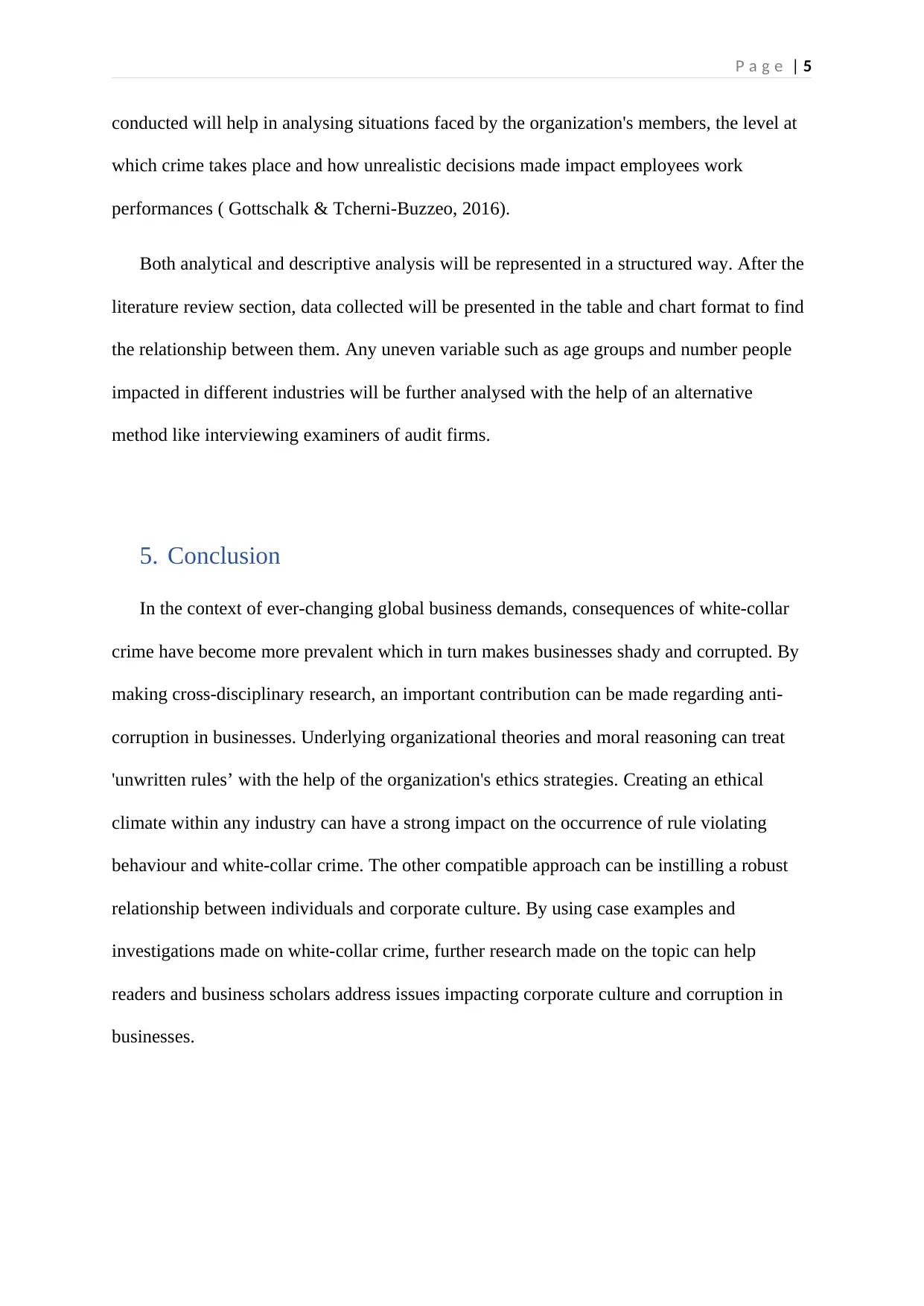
P a g e | 5
conducted will help in analysing situations faced by the organization's members, the level at
which crime takes place and how unrealistic decisions made impact employees work
performances ( Gottschalk & Tcherni-Buzzeo, 2016).
Both analytical and descriptive analysis will be represented in a structured way. After the
literature review section, data collected will be presented in the table and chart format to find
the relationship between them. Any uneven variable such as age groups and number people
impacted in different industries will be further analysed with the help of an alternative
method like interviewing examiners of audit firms.
5. Conclusion
In the context of ever-changing global business demands, consequences of white-collar
crime have become more prevalent which in turn makes businesses shady and corrupted. By
making cross-disciplinary research, an important contribution can be made regarding anti-
corruption in businesses. Underlying organizational theories and moral reasoning can treat
'unwritten rules’ with the help of the organization's ethics strategies. Creating an ethical
climate within any industry can have a strong impact on the occurrence of rule violating
behaviour and white-collar crime. The other compatible approach can be instilling a robust
relationship between individuals and corporate culture. By using case examples and
investigations made on white-collar crime, further research made on the topic can help
readers and business scholars address issues impacting corporate culture and corruption in
businesses.
conducted will help in analysing situations faced by the organization's members, the level at
which crime takes place and how unrealistic decisions made impact employees work
performances ( Gottschalk & Tcherni-Buzzeo, 2016).
Both analytical and descriptive analysis will be represented in a structured way. After the
literature review section, data collected will be presented in the table and chart format to find
the relationship between them. Any uneven variable such as age groups and number people
impacted in different industries will be further analysed with the help of an alternative
method like interviewing examiners of audit firms.
5. Conclusion
In the context of ever-changing global business demands, consequences of white-collar
crime have become more prevalent which in turn makes businesses shady and corrupted. By
making cross-disciplinary research, an important contribution can be made regarding anti-
corruption in businesses. Underlying organizational theories and moral reasoning can treat
'unwritten rules’ with the help of the organization's ethics strategies. Creating an ethical
climate within any industry can have a strong impact on the occurrence of rule violating
behaviour and white-collar crime. The other compatible approach can be instilling a robust
relationship between individuals and corporate culture. By using case examples and
investigations made on white-collar crime, further research made on the topic can help
readers and business scholars address issues impacting corporate culture and corruption in
businesses.
⊘ This is a preview!⊘
Do you want full access?
Subscribe today to unlock all pages.

Trusted by 1+ million students worldwide
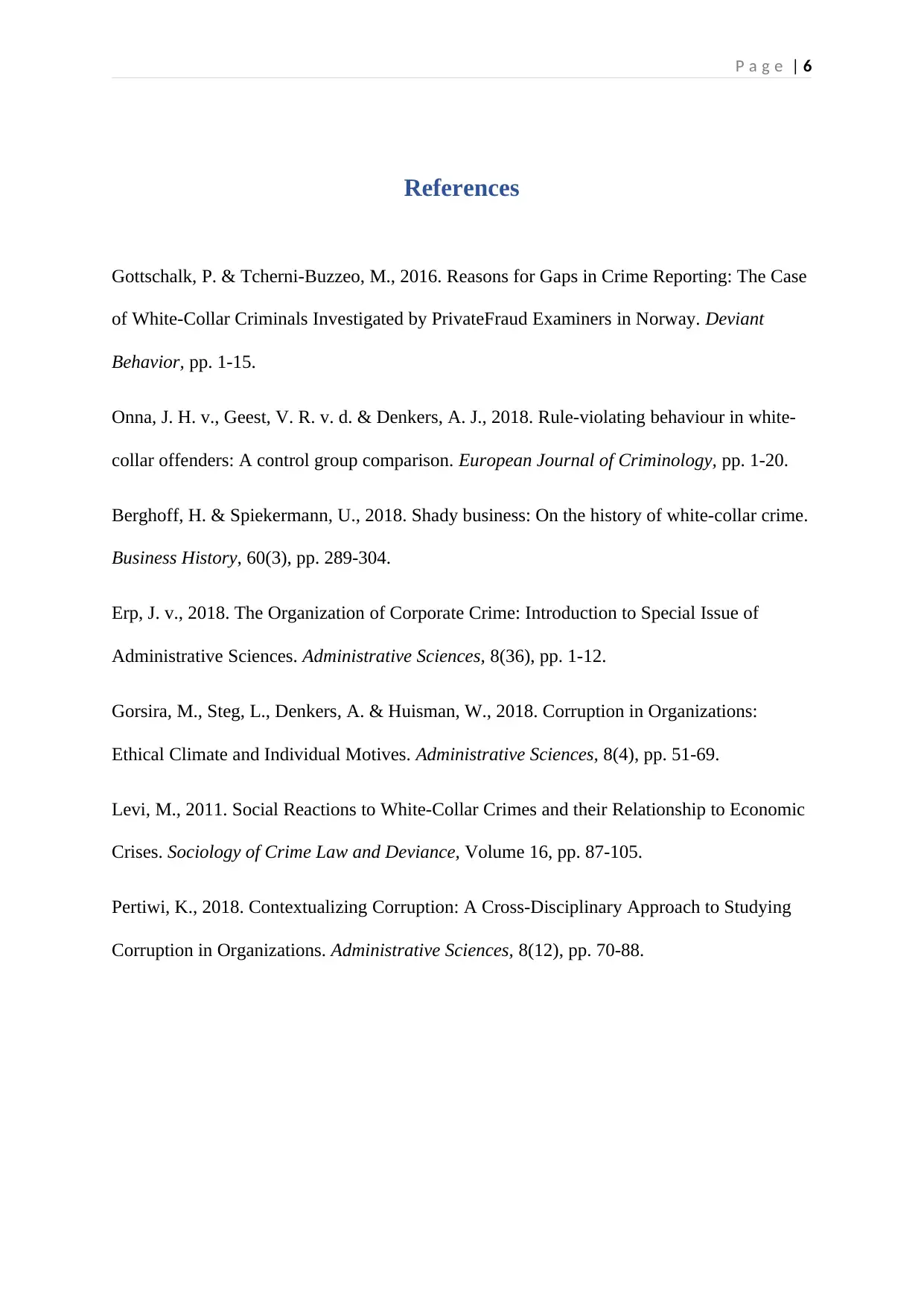
P a g e | 6
References
Gottschalk, P. & Tcherni-Buzzeo, M., 2016. Reasons for Gaps in Crime Reporting: The Case
of White-Collar Criminals Investigated by PrivateFraud Examiners in Norway. Deviant
Behavior, pp. 1-15.
Onna, J. H. v., Geest, V. R. v. d. & Denkers, A. J., 2018. Rule-violating behaviour in white-
collar offenders: A control group comparison. European Journal of Criminology, pp. 1-20.
Berghoff, H. & Spiekermann, U., 2018. Shady business: On the history of white-collar crime.
Business History, 60(3), pp. 289-304.
Erp, J. v., 2018. The Organization of Corporate Crime: Introduction to Special Issue of
Administrative Sciences. Administrative Sciences, 8(36), pp. 1-12.
Gorsira, M., Steg, L., Denkers, A. & Huisman, W., 2018. Corruption in Organizations:
Ethical Climate and Individual Motives. Administrative Sciences, 8(4), pp. 51-69.
Levi, M., 2011. Social Reactions to White-Collar Crimes and their Relationship to Economic
Crises. Sociology of Crime Law and Deviance, Volume 16, pp. 87-105.
Pertiwi, K., 2018. Contextualizing Corruption: A Cross-Disciplinary Approach to Studying
Corruption in Organizations. Administrative Sciences, 8(12), pp. 70-88.
References
Gottschalk, P. & Tcherni-Buzzeo, M., 2016. Reasons for Gaps in Crime Reporting: The Case
of White-Collar Criminals Investigated by PrivateFraud Examiners in Norway. Deviant
Behavior, pp. 1-15.
Onna, J. H. v., Geest, V. R. v. d. & Denkers, A. J., 2018. Rule-violating behaviour in white-
collar offenders: A control group comparison. European Journal of Criminology, pp. 1-20.
Berghoff, H. & Spiekermann, U., 2018. Shady business: On the history of white-collar crime.
Business History, 60(3), pp. 289-304.
Erp, J. v., 2018. The Organization of Corporate Crime: Introduction to Special Issue of
Administrative Sciences. Administrative Sciences, 8(36), pp. 1-12.
Gorsira, M., Steg, L., Denkers, A. & Huisman, W., 2018. Corruption in Organizations:
Ethical Climate and Individual Motives. Administrative Sciences, 8(4), pp. 51-69.
Levi, M., 2011. Social Reactions to White-Collar Crimes and their Relationship to Economic
Crises. Sociology of Crime Law and Deviance, Volume 16, pp. 87-105.
Pertiwi, K., 2018. Contextualizing Corruption: A Cross-Disciplinary Approach to Studying
Corruption in Organizations. Administrative Sciences, 8(12), pp. 70-88.
1 out of 7
Related Documents
Your All-in-One AI-Powered Toolkit for Academic Success.
+13062052269
info@desklib.com
Available 24*7 on WhatsApp / Email
![[object Object]](/_next/static/media/star-bottom.7253800d.svg)
Unlock your academic potential
Copyright © 2020–2025 A2Z Services. All Rights Reserved. Developed and managed by ZUCOL.



